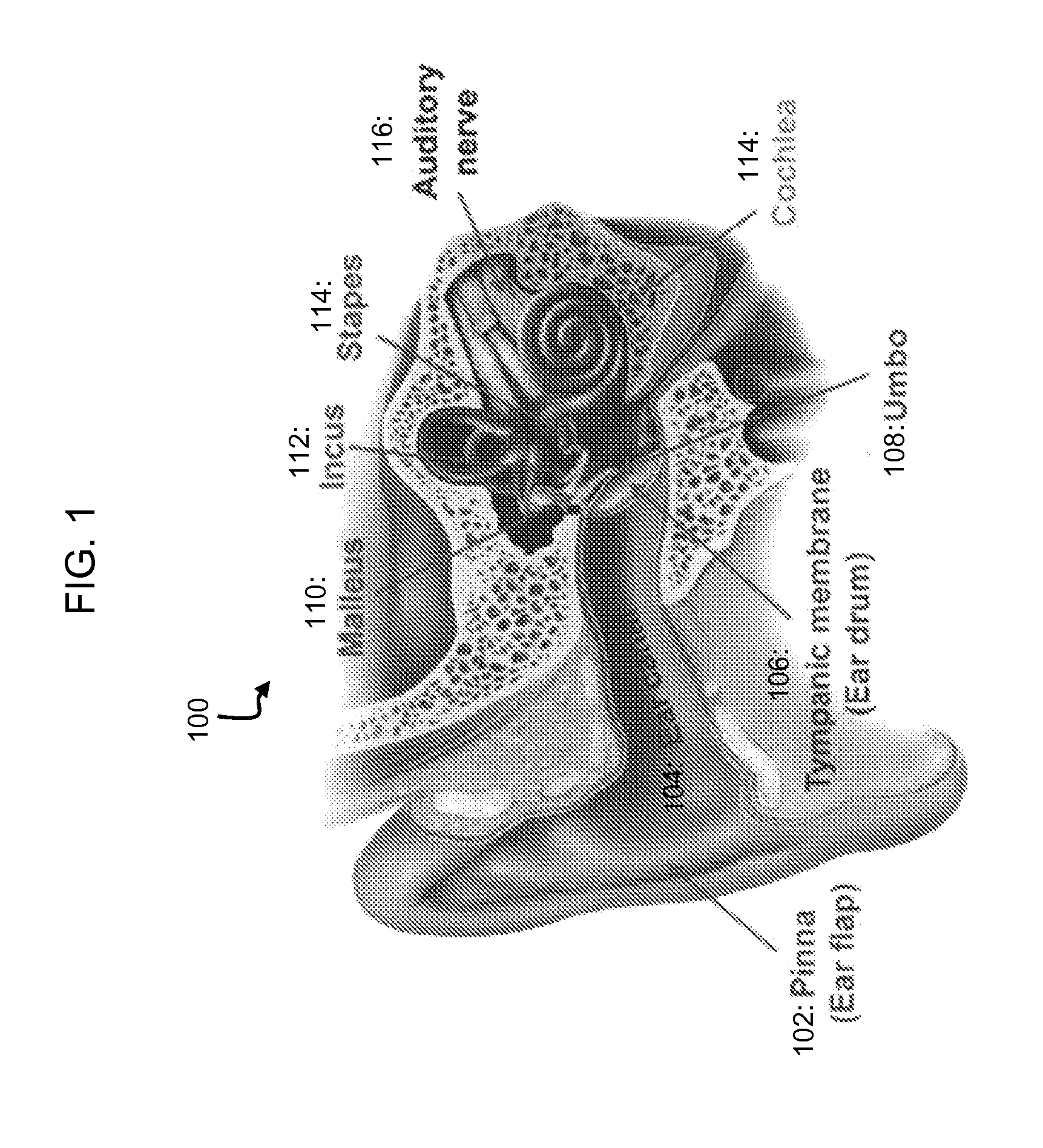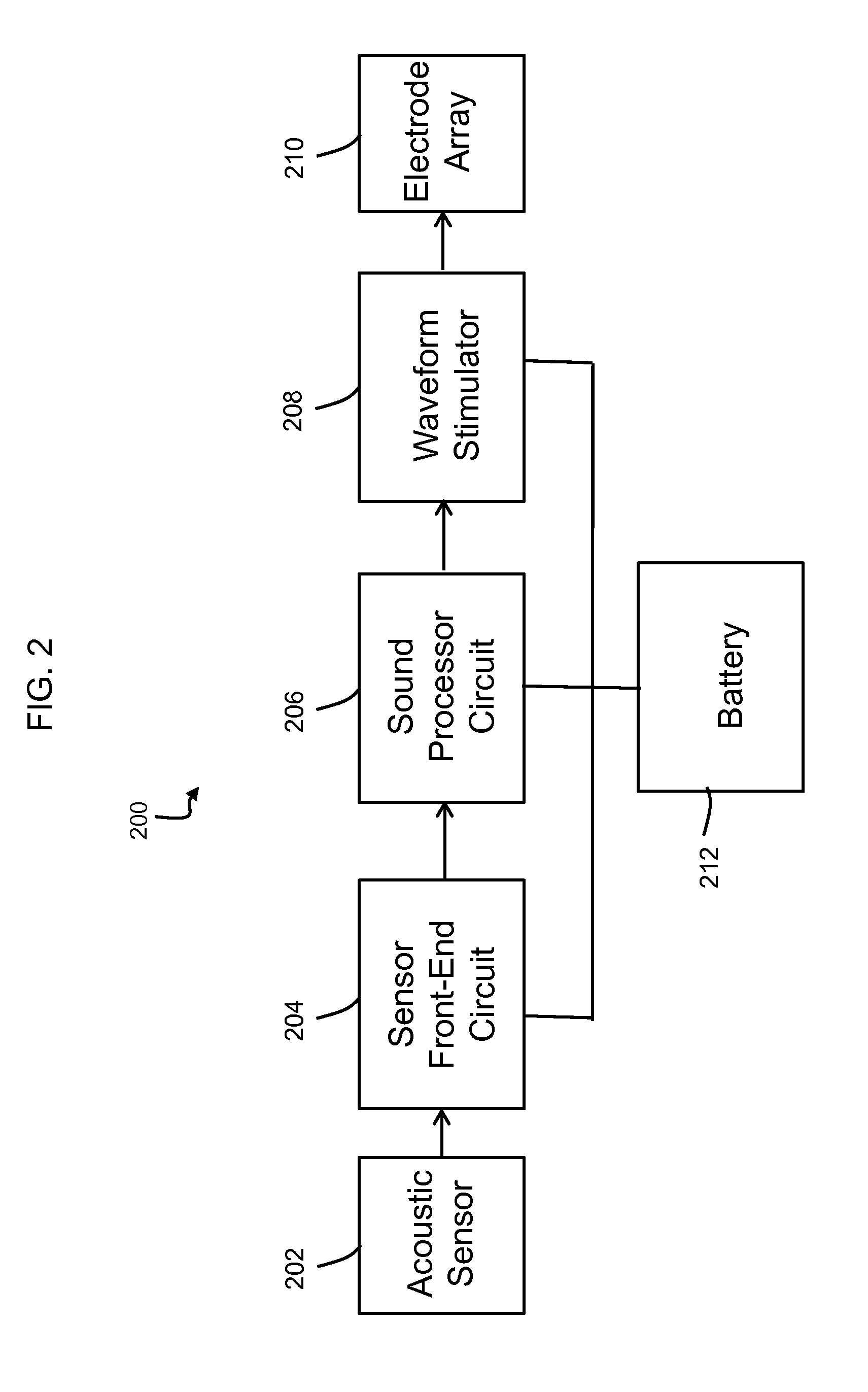Low power cochlear implants
- Summary
- Abstract
- Description
- Claims
- Application Information
AI Technical Summary
Benefits of technology
Problems solved by technology
Method used
Image
Examples
example 1
Fully-Implantable Cochlear Implant
[0161]FIG. 12 shows an image 1200 of a manufactured fully-implantable cochlear implant chip. The chip has a size of 3.6 mm×3.6 mm while the active die area is 3.3 mm2 The chip was fabricated by 0.18 μm high-voltage CMOS technology and packaged in a 128-lead think quad flat package (QFP) package. The chip includes a sensor front-end circuit 1210, sound processor circuit 1230, waveform stimulator 1240, and SPI 1250. In this chip, ADC 1220 is located adjacent to sensor front-end circuit 1210. The sensor front-end circuit 1210 operated with a supply voltage of 1.5 V and the sound processor circuit 1230 operated with a supply voltage of 0.6 V. The ADC 1220 operated at a supply voltage of 0.6 V. The chip were reconfigurable to operate in 4-, 6-, 8-channel modes. Example specifications and power consumption of the chip are described in relation to Table 5-4 in U.S. Provisional Application 61 / 908,237 filed on Nov. 25, 2013, the entire contents of which are ...
example 2
Sound Processor Circuit
[0162]The sound processor circuit 1230 shown in FIG. 12 was tested using an arbitrary function generator (AFG3102 from Tektronix) to generate arbitrary test signals at the input of the ADC 1220. Outputs (dstimA[5:0] through dstimH[5:0]) of the sound processor circuit 1230 were recorded and reconstructed using a computer. All measurements with the ADC 1220 and sound processor circuit 1230 were made at a digital supply voltage of 0.6 V.
[0163]FIGS. 13A-D are images showing a demonstration the ability of the new systems to reconfigure the number of channels of the sound processor circuit 1230. A logarithmic chirp signal was input to the ADC 1220. FIG. 13A is a plot 1310 showing the measured spectrogram at the output of the ADC 1220. FIG. 13B is a plot 1320 showing the measured spectrogram of the sound processor circuit 1230 configured in a 4-channel mode. FIG. 13C is a plot 1330 showing the measured spectrogram of the sound processor circuit 1230 configured in a 6...
example 3
Waveform Stimulator
[0165]An electronic processor and waveform stimulator were used to generate a variety of waveforms by implementing a genetic algorithm. Several examples are described in this section.
[0166]Waveforms were generated over various phase widths. FIGS. 14A-C are plots of energy efficient waveforms for various pulse width. FIG. 14A is a plot 1410 showing the energy efficient waveform for pulse width of 25 μs. FIG. 14B is a plot 1420 showing the energy efficient waveform for pulse width of 50 μs. FIG. 14C is a plot 1430 showing the energy efficient waveform for pulse width of 100 μs. Each waveform in plots 1410-1430 are obtained with 10 steps / phase after 10,000 generations through a genetic algorithm. Phase widths can be generated, but not limited to, from 10 μs to 200 μs. The generated high efficiency waveforms are labeled as 1404 in all three plots. For comparison, a biphasic rectangular waveform at threshold for each of the corresponding phase widths are drawn and labe...
PUM
 Login to View More
Login to View More Abstract
Description
Claims
Application Information
 Login to View More
Login to View More - R&D
- Intellectual Property
- Life Sciences
- Materials
- Tech Scout
- Unparalleled Data Quality
- Higher Quality Content
- 60% Fewer Hallucinations
Browse by: Latest US Patents, China's latest patents, Technical Efficacy Thesaurus, Application Domain, Technology Topic, Popular Technical Reports.
© 2025 PatSnap. All rights reserved.Legal|Privacy policy|Modern Slavery Act Transparency Statement|Sitemap|About US| Contact US: help@patsnap.com



